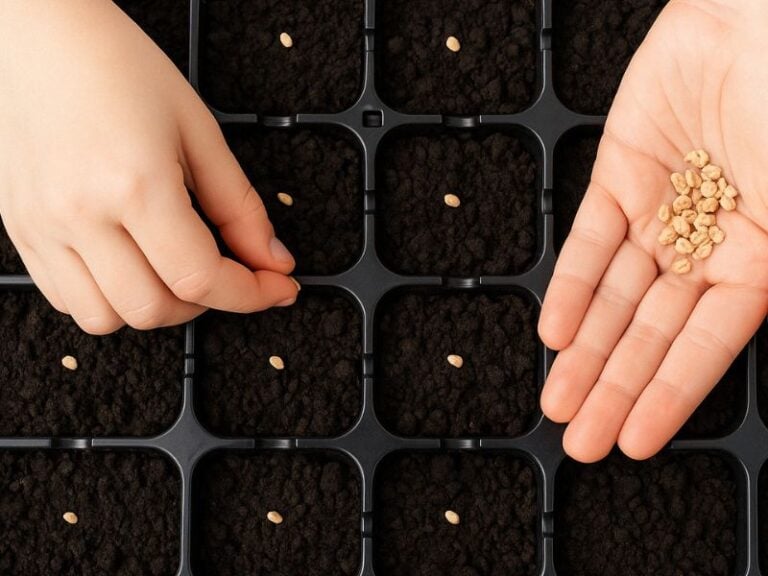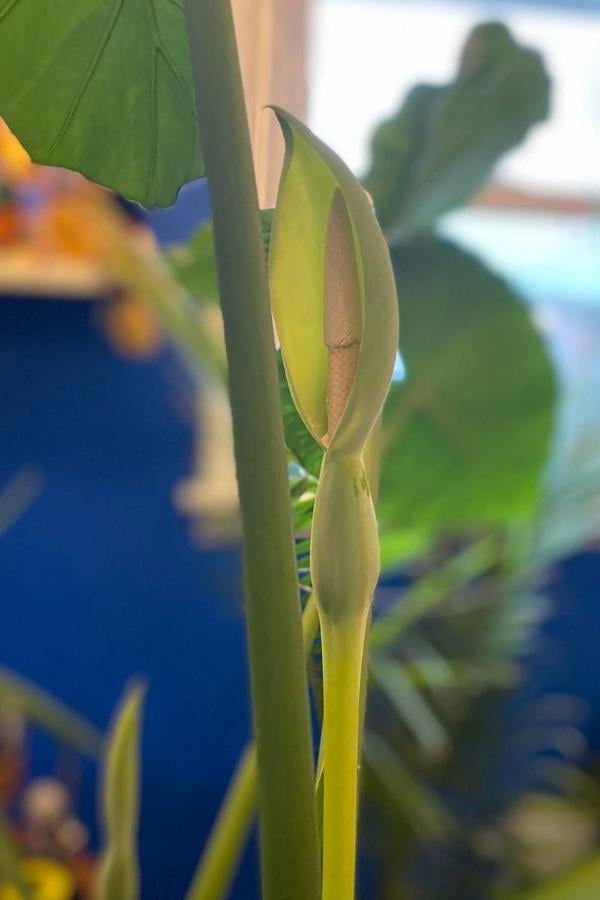Traveler’s Palm (Ravenala) has leaves with straight tips, while the Bird of Paradise (Strelitzia) has pointed ones. The ravenala’s leaf stalks are shaped like a rectangle, while the Strelitzia’s are more round.
The leaves of the ravenala are weaker, almost like mosses, whereas the leaves of the strelitzias are much more substantial.
Ravenala leaves have stems arranged to form a perfect and thin plane, while strelitzia leaves have a cylindrical trunk because the branches form a cylindrical shape.
Contents
How to Differentiate Traveler’s Palm From Bird of Paradise
Both the traveler’s palm and the bird of paradise are tropical plants with similar appearances. So there is confusion and questions about how to tell them apart.
Before we get into the details, here is a table that summarizes the differences between the two plants:
| Traveler’s tree | Bird of Paradise | |
| Common Names | Traveller’s Tree, Ravenala | Bird flower, Fire birds, Bird of Paradise |
| Latin name(s) | Ravenala madagascariensis | Strelitzia |
| Family | Strelitziaceae | Strelitziaceae |
| Vegetation | Perennial | Perennial |
| Height at maturity | > 32 feet | 2 to 6 feet |
| Width at maturity | 18 to 19 feet | 6 to 9 feet |
| Soil type | Sandy soil, Stony soil, Humus | Sandy soil, Stony soil, Humus |
| Soil pH | Neutral to slightly Acid soil | Neutral |
Appearance
Traveler’s Palm
Traveler’s Palm has an almost sculpture-like appearance, and they remind me of the stunning scenery in Madagascar.
Its fan-shaped petioles support its enormous leaves, supported by long and sturdy fan-shaped petioles.
The plant accumulates water between these petioles, which serves to quench the thirst of travelers and eventually earned it its popular name.
Finally, petioles fall and leave scars similar to palm trees on the woody stem.
The traveler’s tree is a member of the Strelitziaceae family and the bird of paradise ( Strelitzia).
It is widely used in landscaping to add a touch of the tropics to large backyards, farms, and public spaces.
It grows in the form of a thin, ringed stipe composed of interlocking petioles that appear alternately on a single plane.
As new leaves appear in the center of the fan, the old ones dry out and fall off, releasing the stipe.
Because the fan is almost 20 feet in diameter, the new plants should grow in the same direction as the mother plant.
Bird of Paradise
Some birds of paradise are so large that sometimes they’re called trees. The trunk of the plant makes it resemble a tree.
It’s made up of thick petioles of tightly packed leaves.
Because of this, the false traveler’s Palm is another name for a bird of paradise.
They dry out and fall off as they get older. Scars are all that are left, giving it the appearance of a palm tree.
That why is why you may get confused with the traveler’s tree.
By the way, they’re false palms that are herbs. Unlike traveler’s Palm, some strelitzia leaves have a solid edge rather than a slit down the middle.
Height
The traveler’s tree (Ravenala madagascariensis) is a giant herbaceous plant native to Madagascar but widespread in the tropics.
This tree-like perennial found in tropical rainforests can grow up to 32 feet or even 98 feet high in the right conditions.
Bird of Paradise (Strelitzia) is an evergreen and perennial flowering plant. Strelitzia is a South African plant that belongs to the Strelitziaceae family.
It typically reaches a height of between 6 and 11 feet, but some species can grow as high as 30 feet. The rate of growth also depends on what kinds of strelitzia you are growing.
Leaf Size and Type
Traveler’s Palm
Each leaf is approximately 10 feet in length and has a stalk that is almost 2/3 as long as the leaf itself, giving it the appearance of a paddle.
The fan’s blade resembles a banana tree ripped apart by the wind, enhancing the fan’s feathery look.
Bird of Paradise
Among the birds of paradise, Strelitzia reginae is the most well-known for its fan-shaped, long, dark green leaves on long petioles emerging directly from the root neck.
They look a lot like banana leaves but are much denser. The leaves range in length from 11-75 inches, and the stems go from 20 to 35 inches.
Flowers and Fruits
Traveler’s Palm
Flowering occurs in the fall, and the fruit is brown capsules with iridescent blue aril seeds that attract birds.
Bats and lemurs are the primary pollinators of the traveler’s tree.
When the plant reaches a height of more than 9 feet, it begins to bloom.
The inflorescences grow between the petioles and out of the fan to help birds that eat nectar pollinate the plant.
Traveler’s Palm flowers appear between the petioles, with green, boat-shaped bracts and showy white, creamy flowers.
Green to purplish-green bracts and flowers form a set that looks like a bird’s crest, complete with a beak and pointed tip.
They can fit a row of flowers measuring 6 inches long in their hollow, each with six white pointed tepals, six stamens, and a single pistil.
Then, towards the vessel’s stern, new flowers begin to form.
The fruits are 8-inch brown woody capsules with thick walls. They have many black seeds wrapped in an organ called the aril, which is a stunning emerald blue.
Bird of Paradise
In addition to two orange sepals and two blue petals, the flower is made up of a tough bract attached to a long floral stalk of more than one meter in length. The set resembles the head of a tropical bird.
Bird of Paradise Care Guide
Location and Lighting
This tropical plant thrives both indoors and out. Since its roots aren’t invasive, you’ll almost always find it in a pot. However, you can also plant it in the garden.
Light and temperature will be the most critical factors in its location.
Strelitzia prefers warm and temperate climates because it cannot withstand freezing temperatures.
Although it can withstand brief exposure to temperatures as low as 32 °F, this is not recommended.
The most important thing for her is to have the most natural light possible and to be able to spend several hours a day in direct sunlight, even if she is indoors.
Ideally, you’ll want to put it near a window so that it gets some natural light during the day.
Also, the tips of its leaves will burn less if you avoid the middle of the day.
Watering
Strelitzia watering is moderate in summer; it needs water 1 or 2 times a week. Before you water again, you should always wait until the top of the soil is completely dry.
You can water your plants only once every 15 days during the winter months, which is more than sufficient.
A Little Extra Energy
During the growing seasons, spring and summer, it is best to fertilize the Strelitzia every 15 days by adding liquid fertilizer to the irrigation water.
Blooms at the Age of 4 to 6 Years
It is one of the most popular flowers for floral centerpieces and decoration, but it isn’t always easy to obtain.
The Strelitzia must be at least four or six years old before it can produce flowers.
In addition, it will only bloom if it grows at the right temperature and humidity.
Treats Your Strelitzia To The Next Level
There are two easy ways to improve the health of your plant.
The first is to mist its leaves with water in the summer to keep them moist. You can also wipe its large leaves with a damp cloth.
Traveler’s Palm Care Guide
Where to Plant The Traveler’s Palm
A large area in an open space with full sun during the day is ideal for growing the traveler’s tree.
It thrives in moister, warmer climates where the soil is rich in organic matter to ensure healthy development.
How To Care For A Traveler’s Palm
Regular soil watering is necessary to keep the traveler’s tree from growing in a dry environment while also preventing the soil from becoming too saturated.
Additionally, removing the plant’s dry branches helps maintain its beauty and growth. It is a species that grows well in the wild, so it doesn’t need much care daily.
Great for people who don’t have much time for maintenance.
How to Grow a Traveler’s Palm
Usually, the traveler’s tree is grown from seeds, which can take a while to sprout. However, shoots can be used to make new seedlings and replant them.
Isn’t it incredible? A traveler’s Palm at home is simple to maintain and requires little time or effort.











